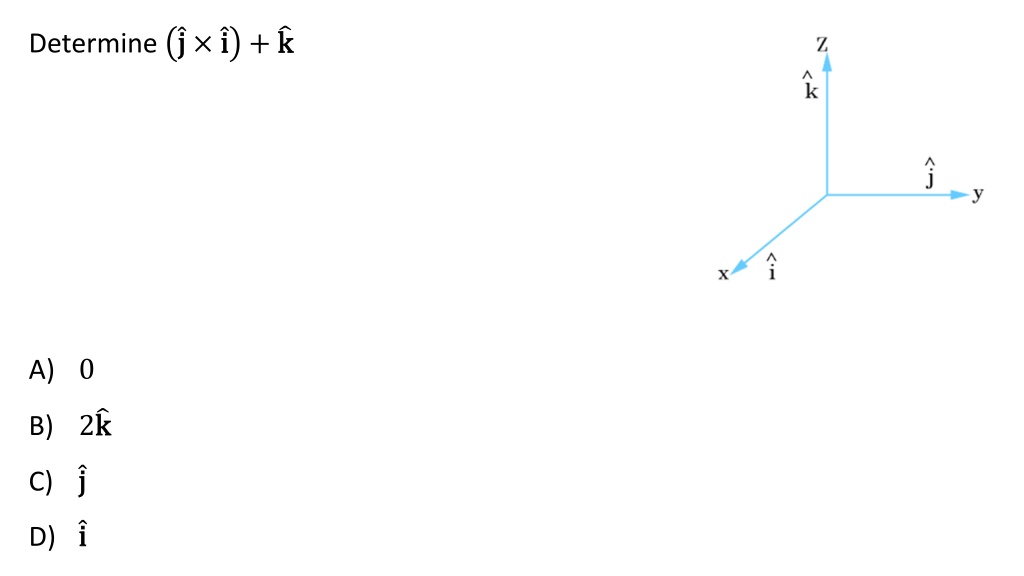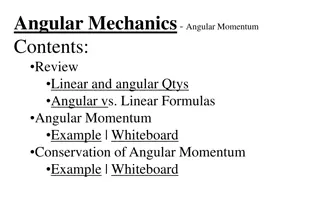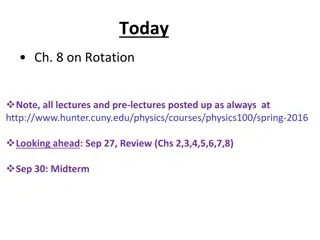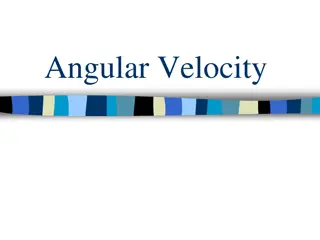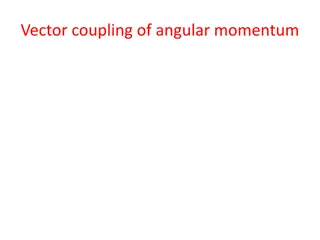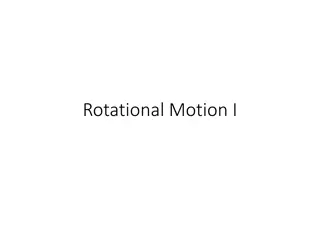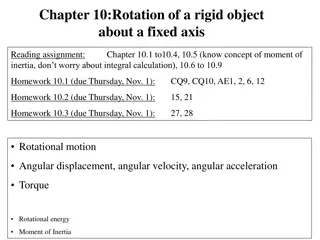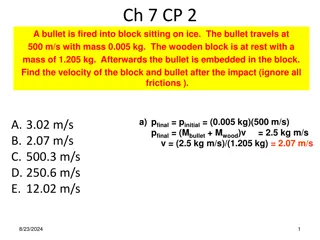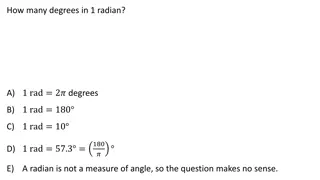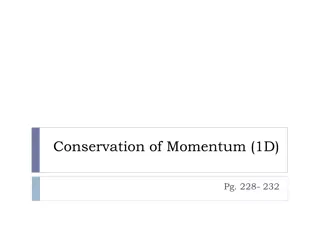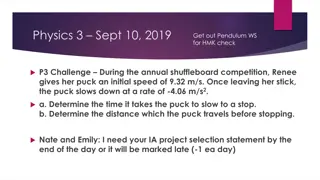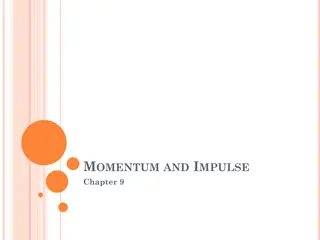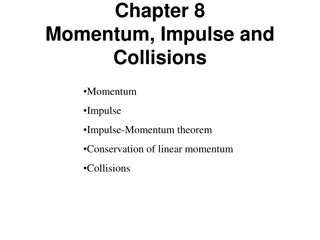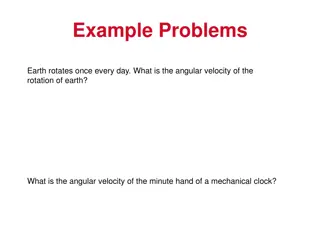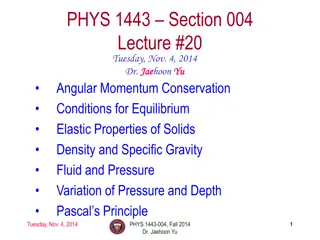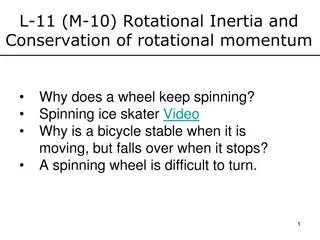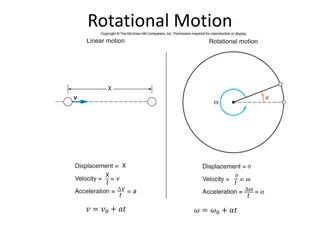Understanding Angular Momentum and Rotational Dynamics in Physics
Explore concepts related to angular momentum, torque, and rotational dynamics in physics. Learn about the behavior of spinning objects, the effects of changing moments of inertia, and how angular momentum is conserved in different scenarios.
Download Presentation

Please find below an Image/Link to download the presentation.
The content on the website is provided AS IS for your information and personal use only. It may not be sold, licensed, or shared on other websites without obtaining consent from the author. Download presentation by click this link. If you encounter any issues during the download, it is possible that the publisher has removed the file from their server.
E N D
Presentation Transcript
Determine j j i i +k k A) 0 B) 2 k k C) j j D) i i
A planet in circular orbit about the Sun is in the position shown. When the origin is located at the Sun, the vector torque on the planet planet y planet S x S z A) is zero. B) points along the +? axis. C) lies in the ?? plane. D) None of these
How does the magnitude of the angular momentum of the planet ?planet (with the origin at the Sun) at positions A and B compare? B A S A) ??= ?? B) ??> ?? C) ??< ??
Recall that the vector angular momentum of a spinning object is ? = ??. Three identical wheels, all with moment of inertia ?, are spinning with the same ?, so ?tot 3 wheel system= 3??. If one of the wheels is flipped upside-down (the magnitude of its angular velocity, ?, stays constant), the new ?tot 3 wheel system= A) 3??. B) 2??. C) ??. D) None of these
Two different spinning disks have the same angular momentum, but disk 1 has more kinetic energy than disk 2. Which one has the bigger moment of inertia? Disk 1 (more KE) Disk 2 (less KE) A) Disk 1 B) Disk 2 C) Not enough info
A star is originally rotating with a period ?. Over a period of a million years, its radius decreases by a factor of 2. What is the new period of the star? [Hint: ?sphere=2 5??2] A) ?/2 B) 2T C) 4T D) T/4 E) None of these
The mass-disk system rotates, and the axle is frictionless. Ant Man carries the mass m toward the center of the rotating disk. As Ant Man moves inward, the magnitude of the angular momentum ?of the system (ant + platform + m) A) increases. B) decreases. C) remains constant.
The mass-disk system rotates, and the axle is frictionless. Ant Man carries the mass m toward the center of the rotating disk. As Ant Man moves inward, the magnitude of the angular velocity ?of the system (ant + platform + m) A) increases. B) decreases. C) remains constant.
The mass-disk system rotates, and the axle is frictionless. Ant Man carries the mass m toward the center of the rotating disk. As Ant Man moves inward, the kinetic energy of the system (ant + platform + m) A) increases. B) decreases. C) remains constant.
A cylinder with moment of inertia ??= 10 kg m2 is rotating on a frictionless platform with initial angular velocity of magnitude ??= 4 rad/s. A second non- rotating cylinder with ??= 5 kg m2 is dropped onto the first as shown, and the two cylinders then rotate together. We seek the final angular velocity of the cylinders ??. Does conservation of angular momentum apply in this problem? A) Yes B) No C) Depends on how much friction there is between the cylinders
A cylinder with moment of inertia ??= 10 kg m2 is rotating on a frictionless platform with initial angular velocity of magnitude ??= 4 rad/s. A second non- rotating cylinder with ??= 5 kg m2 is dropped onto the first as shown, and the two cylinders then rotate together. We seek the final angular velocity of the cylinders ??. Is the following equation true? ????= ???? A) Yes B) No
A student is sitting at rest on a rotation stool with her feet off the ground. The student is handed a wheel that is not rotating. Now, the student spins the wheel. Which way will the student begin to rotate? A) In the same direction as the wheel B) In the opposite direction C) The student will remain at rest
A student is sitting at rest on a rotation stool with her feet off the ground. The student is handed a wheel that is already rotating. Which way will the student begin to rotate? Hint: the wheel s axle is frictionless, and it doesn t speed up or slow down during the handoff. A) In the same direction as the wheel was rotating B) In the opposite direction C) The student will remain at rest
A student is sitting at rest on a rotation stool with her feet off the ground. The student is handed a wheel that is already rotating. Now, the student stops the wheel with her arm. Which way will the student begin to rotate? A) In the same direction as the wheel was rotating B) In the opposite direction C) The student will remain at rest
A student is rotating on a rotation stool hold masses at arms length. Now, the student drops the masses. How will the student s motion change? A) She will speed up B) She will slow down C) Her motion will be unchanged
A student is sitting at rest on a rotation stool, holding a spinning wheel with vertical axis. The wheel has angular momentum ??. The student then inverts the wheel. (It still spins at the same rate.) After the flip, ?person + stoolis [Note: I want ?person + stool not ?person + stool+wheel] A) 0. B) ??. C) 2??. 1 2??. D) E) None of these
A mass ? is supported by two threads. The free-body diagram correctly shows the directions of the forces but does not correctly show their magnitudes. Which tension is larger? A) ?1 B) ?2 C) ?1 and ?2 are equal D) Not enough info
A door is pushed by two forces, a smaller force at the door knob AND a larger force nearer the hinge as shown. The door does not move. The component of the force on the door by the hinge in the xy-plane Big force hinge y x Small force. A) is zero. B) points (along +y) C) points (along y) D) points (between +x and y) E) points (between +x and +y)
A light board of length 4? is stationary. Four forces, all of the same magnitude ?, are being applied as shown. If we choose the left end of the board as the axis of rotation, then ?netabout that axis is F axis F + F F d d d d A) zero. B) positive (+). C) negative (-).
A light board of length 4? is stationary. Four forces, all of the same magnitude ?, are being applied as shown. If we choose the axis of rotation to be as shown, then ?netabout that axis is F axis F + F F d d d d A) zero. B) positive (+). C) negative (-).
A bridge is supported on both ends. A 20 N car is one third of the way across the bridge. The extended free body diagram looks like (ignore the weight of the bridge).
A bridge is supported on both ends. A 20 N car is one third of the way across the bridge. Which is the correct equation for the sum of forces? A) F1+ F2 W = 0 B) F1+ F2+ W = 0 C) F1+ F2=0 D) F1+ F2+ W = 0
A bridge is supported on both ends. A 20 N car is one third of the way across the bridge. To find ?1in the quickest way possible, we should choose the axis to be A) the left end. B) the right end. C) the center. D) the car location.
A bridge is supported on both ends. A 20 N car is one third of the way across the bridge. Choosing the right end as the axis, the torque is A) L F1+2L 3W = 0 B) L F1 2L 3W = 0 C) L 3F1+2L 3F2=0 L 3F1+2L 3F2= 0 D)
A bridge is supported on both ends. A 20 N car is one third of the way across the bridge. Calculate ?1. A) 20 N 2 3 20 N = 13.3 N B) 1 3 20 N = 6.7 N C)
A bridge is supported on both ends. A 20 N car is one third of the way across the bridge. Given that ?1= 13.3 N, calculate ?2. A) 33.3 N B) 20 N C) 13.3 N D) 6.6 N
A bridge is supported on both ends. A 20 N car is one third of the way across the bridge. Forget the previous questions and choose a different axis location: the position of the car. What can we immediately say about the ratio ?1 ?2? A) 2/3 B) 1/3 C) 1/2 D) 2
A 1 kg ball is hung at the end of a rod 1 m long. If the system balances at a point on the rod 0.25 m from the end holding the mass, what is the mass of the rod? A) kg B) kg C) 1 kg D) 2 kg E) 4 kg
A (static) mobile hangs as shown below. The rods are massless and have lengths as indicated. The mass of the ball at the bottom right is 1 kg. What is the total mass of the mobile? A) 5 kg B) 6 kg C) 7 kg D) 8 kg E) 9 kg
Two forces are applied to a (very thin) bar as shown in the diagram. Force ? is applied at a 45 angle at the center of the bar; force 4? is applied at a 90 angle at the right end of the bar. Is it possible to maintain the bar in static equilibrium by applying an appropriate third force at the left end of the bar? A) Yes, sure B) No way
A mass ? is hung from a clothesline stretched between two poles as shown. As a result, the clothesline sags very slightly as shown. ?clothesline= A) ?? B) ??/2 C) slightly greater than ??/2 D) considerably greater than ??/2 E) considerably less than ??/2
You make a desk by attaching a wide shelf (assumed to be massless!) to the top of two legs. When you put a heavy book down on the end of the shelf, the force exerted ON the shelf at the attachment point A is (Book) A B (shelf) A) B) C) D) E) Zero
A ladder of weight ?? leans against a wall. The ladder has rollers at the top so that the wall exerts a normal force only on the top of the ladder. A person of weight ?? slowly climbs the ladder. An extended free body diagram for the ladder is shown. As the person ascends the ladder, the force from the wall (?wall) A) increases. B) decreases. C) remains the same.
A ladder of weight ?? leans against a wall. The ladder has rollers at the top so that the wall exerts a normal force only on the top of the ladder. A person of weight ?? slowly climbs the ladder. An extended free body diagram for the ladder is shown. As the person ascends the ladder, the force of friction (??) A) increases. B) decreases. C) remains the same.
A ladder of weight ?? leans against a wall. The ladder has rollers at the top so that the wall exerts a normal force only on the top of the ladder. A person of weight ?? slowly climbs the ladder. An extended free body diagram for the ladder is shown. The ladder is more likely to slip when the person is A) lower. B) higher. C) Doesn t matter
